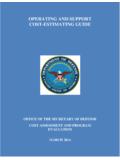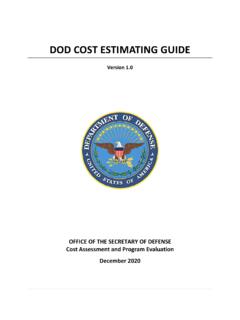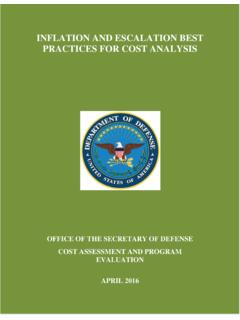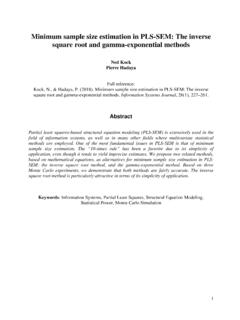Transcription of OPERATING AND SUPPORT COST-ESTIMATING GUIDE
1 OPERATING AND SUPPORT . COST-ESTIMATING GUIDE . OFFICE OF THE SECRETARY OF DEFENSE. COST ASSESSMENT AND PROGRAM. EVALUATION. SEPTEMBER 2020. This page intentionally left blank. Contents 1. INTRODUCTION .. 1. 1. Applicability .. 1. 1. 2. OVERVIEW OF LIFE-CYCLE COSTS .. 3. Life-Cycle Cost Categories .. 3. Cost Categories as a Percentage of Life-Cycle Cost .. 4. Overview of O&S Cost Scope and Definitions .. 6. 3. OSD COST ELEMENT STRUCTURE .. 7. Introduction .. 7. 9. 4. DIFFERENT METRICS OF O&S COSTS .. 19. Introduction .. 19. O&S Cost Categorizations .. 19. O&S Cost Metrics .. 25. 5. ROLE OF O&S COSTS .. 33. Acquisition Milestone and Other Reviews .. 33. Sustainment Reviews .. 34. Other Roles of O&S Cost Estimates and Analyses .. 34. Selected Acquisition Report .. 34. 6. SOURCES OF O&S COST DATA .. 37. VAMOSC Program .. 37. Cost Reporting for Sustainment Contracts .. 39. 7. O&S COST ESTIMATING PROCESS .. 47. Introduction .. 47. Program Definition .. 48. Cost Estimating Plan.
2 50. Cost 56. Cost Estimate .. 58. iii Appendices APPENDIX A Software Maintenance Cost 69. APPENDIX B Indirect SUPPORT Cost Elements .. 73. APPENDIX C Definitions for Acquisition Logistics SUPPORT Cost Elements .. 77. APPENDIX D Mapping from O&S Cost Elements to Budget Appropriations .. 81. APPENDIX E Analytic SUPPORT for Sustainment Reviews .. 85. APPENDIX F DoD Maintenance and Supply .. 101. APPENDIX G Product SUPPORT Cost Estimate at the Component Level of Detail .. 109. APPENDIX H Relevant Statutory Requirements .. 123. APPENDIX I Rates for Military and Civilian Manpower .. 135. APPENDIX J References .. 137. Abbreviations .. 139. Glossary .. 143. Figures Figure 2-1. Illustrative System Life Cycle ..3. Figure 2-2. Major Cost Categories as % of Total Life-Cycle Cost for Selected System Types ..5. Figure 3-1. Second/Third Level of Cost Element Structure ..8. Figure 4-1. O&S Cost Elements ..19. Figure 4-2. O&S Cost Categorizations ..24. Figure 4-3. O&S Cost Categorizations (cont.)
3 25. Figure 4-4. Examples of Aircraft O&S Cost Metrics ..26. Figure 4-5. Examples of Aircraft O&S Cost Metrics (cont.) ..27. Figure 4-6. Effect of System Usage on O&S Cost Metrics ..28. Figure 4-7. Example of Normalization of $/Flight Hour Metric ..29. Figure 4-8. Example of Various $/Flight Hour Metrics ..30. Figure 6-1. Flexfile Report for Sustainment Data Figure 6-2. CSDR Sustainment WBS for Figure 6-3. CSDR Standard Functional Categories for Sustainment ..43. Figure 6-4. Maintenance and Repair Parts Report Data Elements ..44. Figure 6-5. Software Maintenance Report Data Elements ..45. Figure 7-1. Recommended O&S Cost Estimating Process ..48. Figure 7-2. Typical System Characteristics and Program Content ..49. Figure 7-3. Nominal System Life Figure 7-4. Nominal System Life Durations (cont.) ..53. iv Figure 7-5. Example of O&S Phasing Convention ..54. Figure 7-6. Inflation/Escalation Index Selection GUIDE ..55. Figure 7-7. Example of Analogy Cost Estimate.
4 59. Figure 7-8. Example of Cost Estimate by CER ..61. Figure 7-9. Example of Sensitivity Analysis ..63. Figure 7-10. Second Example of Sensitivity Analysis ..64. Tables Table 4-1. Cost Element Composition of O&S Categorizations ..20. Table 4-2. Cost Element Composition of O&S Categorizations (cont.) ..21. Table 4-3. Cost Element Composition of O&S Categorizations (cont.) ..23. Table 7-1. Comparison of Replacement Systems to Antecedents ..60. Table E-1. Track of Aircraft Fuel Table G-1. Avionics Components Input Table G-2. Avionics Components Input Data (continued) ..112. Table G-3. SUPPORT Equipment Input Data ..114. Table G-4. Technical Data Input Data ..115. Table G-5. Training and Training Devices Input Data ..116. Table G-6. Total Acquisition Logistics Table G-7. Total O&S v This page intentionally left blank. 1. INTRODUCTION. Purpose This GUIDE was prepared by the Office of the Secretary of Defense (OSD) Director of Cost Assessment and Program Evaluation (DCAPE) for use by the Department of Defense (DoD).
5 Military departments and defense agencies in developing estimates of system OPERATING and SUPPORT (O&S) costs. Applicability This GUIDE is focused on analytic methods and data for O&S cost estimates and analyses for a wide variety of DoD weapon systems. Outline The remainder of this GUIDE is organized as follows: Chapter 2 provides an overview of the concepts of system life-cycle cost and system O&S cost. Chapter 3 provides the standard OSD O&S cost element structure. The cost element structure is an organized and defined taxonomy of O&S cost elements. Chapter 4 describes various categorizations of O&S cost elements, and associated O&S. cost metrics, that are used for a variety of different purposes. Chapter 5 discusses the uses of O&S cost estimates and analyses in SUPPORT of the defense acquisition process throughout the program life cycle. Chapter 6 provides a summary of the O&S cost and related data systems that are available to the DoD cost community, including contractor cost data reporting for major sustainment contracts.
6 Chapter 7 provides a tutorial on the best practices for planning, conducting, presenting, and documenting O&S cost estimates. This GUIDE also has several appendices: Appendix A provides an optional, more detailed cost element structure for software maintenance. Appendix B provides terms and definitions for O&S-related indirect costs. Appendix C provides terms and definitions for acquisition cost elements associated with system product SUPPORT . 1. Appendix D provides a mapping from OSD O&S cost elements to budget appropriations. Appendix E provides a recommended analytic approach that can be used to SUPPORT sustainment reviews of major weapon systems after initial operational capability. Appendix F provides background on DoD maintenance and logistics for major weapon systems. Appendix G provides an example of an O&S cost estimate at the component or black box level of detail. Appendix H describes the extensive and demanding statutory and regulatory requirements associated with O&S cost estimates and analyses, weapon system sustainment, and life-cycle product SUPPORT .
7 Appendix I provides information on rates for military and civilian manpower. Appendix J provides the references used throughout this GUIDE . This GUIDE also has a list of abbreviations and a glossary. 2. 2. OVERVIEW OF LIFE-CYCLE COSTS. Life-Cycle Cost Categories Life-cycle cost is defined as the sum of four major cost categories: (1) research and development costs; (2) investment costs, consisting of procurement and military construction costs; (3) O and (4) disposal costs. Figure 2-1 depicts a notional profile of annual program expenditures by major cost category throughout the system life cycle for a program acquired using the Major Capability Acquisition pathway. The profile for an actual program will vary significantly by system type and the program's Adaptive Acquisition Framework pathway. Figure 2-1. Illustrative System Life Cycle 3. These costs occur over the phases of an acquisition program as defined in the acquisition process. The research and development costs occur during the materiel solution analysis phase, the technology maturation and risk reduction phase, and the engineering and manufacturing development phase; the investment costs occur during the production and deployment phase; the O&S costs occur during the operations and sustainment phase; and the disposal costs occur during the disposal phase.
8 Note that in the standard terminology for life-cycle cost, there are acquisition logistics SUPPORT costs that are part of the program's procurement cost. These costs are the initial investment and a vital enabler for a program's product SUPPORT . Definitions for the acquisition logistics SUPPORT cost elements are provided in MIL-STD-881D, Work Breakdown Structures for Defense Materiel Items, Appendix K (Common Elements). The acquisition cost elements are part of the Work Breakdown Structure (WBS) for each major system type ( , aircraft, ground vehicle, etc.). The acquisition logistics SUPPORT cost elements are described in Appendix C of this GUIDE . Cost Categories as a Percentage of Life-Cycle Cost For many types of programs, the system O&S costs will be the largest of the four cost categories. Figure 2-2 presents the percentage of program life-cycle cost associated with O&S. costs (for eight system types). 4. Figure 2-2. Major Cost Categories as % of Total Life-Cycle Cost for Selected System Types The percentages are based on data taken from Selected Acquisition Reports (SARs).
9 For programs still actively reporting at the time of the publication of this GUIDE , the data were taken from the December 2019 SARs. For other programs, the data were taken from the last SAR for that program. In all cases, the data were converted to FY 2020 dollars before calculating the percentages displayed. Note that in SARs, the investment cost category is not provided per se. Rather, the SARs provide separate costs for procurement and military construction. Military construction costs are normally not a significant life-cycle cost element in most programs. The actual percentage will vary from program to program, albeit for some system types, such as space systems and tactical missiles, the percentages for O&S costs will be much lower. Space systems have O&S costs primarily associated with sustainment of the ground stations. Tactical missiles have O&S costs primarily associated with stockpile surveillance, storage costs, and sustaining engineering and program management.
10 Nevertheless, given the relative importance of O&S costs for many DoD major weapon systems, this GUIDE has been issued to stress that importance and provide advice on estimating and managing these costs. 5. Overview of O&S Cost Scope and Definitions At the broadest level, O&S costs consist of all sustainment costs incurred from the initial system deployment through the end of system operations. This would include all costs of OPERATING , maintaining, and supporting a fielded system. Specifically, this consists of the costs (organic (government civilian and military) and contractor) of personnel, equipment, supplies, software, and services associated with OPERATING , modifying, maintaining, supplying, and otherwise supporting a system in the DoD inventory. These costs include those associated with the system-specific training of personnel necessary to SUPPORT the system. Chapter 3 of this GUIDE provides further structure and definitions for the system O&S cost elements.




